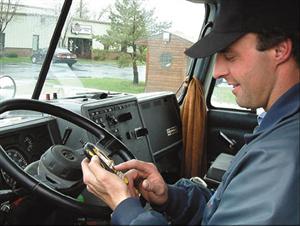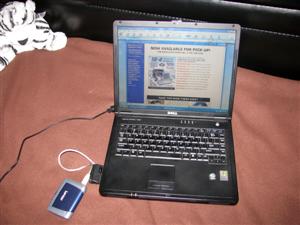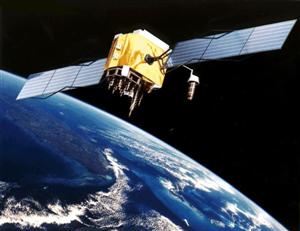March 2009 TRUCKER TALK
HIGH-TECH TRUCKING
BY WRITER & OWNER OPERATOR KIM GRIMM
Who could have ever imagined the technologies that we would be using in trucking today? It seems like only a few years ago that the “brains” of computers occupied entire rooms in office buildings. The computers of today, which are more powerful than the ones as big as a room, are now small enough to slip into a carrying bag and can be taken into the truck with you. Add to that the wonders of wireless technology, and you now have the world at your fingertips, literally, while out on the road.
Today, it seems that some drivers are relying on their computers almost as much as their trucks to help run their business. With software programs that keep track of expenses, plan routes, get directions and find the cheapest fuel, a computer is a valuable tool for running a trucking business. And now that you can access the internet on your laptop, right from your cab, using a cell phone card, you can even look at load boards and find your next load before you even deliver the one you’ve got onboard.
Most cell phone providers offer a phone card that lets you log on to the internet, using your laptop, wherever you can get a signal. My plan is $59.95 per month with unlimited minutes, and I think this is pretty much the going rate. Not a bad price, considering all that this card can provide. WIFI hotspots are also available, but I don’t think that they are the best option for drivers.
Working with your accountant, you can design a computer program for your individual operation. Every trucker has the same basic expenses, such as fuel and maintenance, but depending on what you haul, these programs can allow you to customize your other expenses (a driver pulling oversized loads will have permit and escort fees that the driver pulling a reefer or a van won’t have). The really computer savvy driver may even go so far as to keep track of all the mileages on parts replaced in an easy to read format, instead of scratched-out notes, written in a book, that you have to search through to find anything. There are also generic computer programs out there that are made specifically for truckers.
Customized “trucker programs” can make tax time so much easier for your tax preparer (or you, if you prepare your own). Instead of the time-consuming job of sorting through a box of receipts and then recording and adding them, you just have to make a few simple entries and you are done. If you input all of your receipts throughout the year, all of the information is already there. You will also have a better idea of where your business stands all year long, so you are more able to make necessary adjustments in your business throughout the year, at just the touch of a button (or two).
 Routing is another benefit truckers get from today’s technology, either by getting maps and directions online or through a GPS system. Sometimes, while listening to the radio, I wonder if some drivers even own a map. How did we ever find where we were going all these years before GPS? But you have to be careful with these systems – especially when you are in a place with lots of low overpasses, weight limits and residential streets that don’t allow trucks.
Routing is another benefit truckers get from today’s technology, either by getting maps and directions online or through a GPS system. Sometimes, while listening to the radio, I wonder if some drivers even own a map. How did we ever find where we were going all these years before GPS? But you have to be careful with these systems – especially when you are in a place with lots of low overpasses, weight limits and residential streets that don’t allow trucks.
I recently got directions from Google that were a little less than desirable. Of course, I got the load after everyone had gone home on Friday and I had to be at the delivery location early on Monday morning, so there wasn’t really anyone to ask for good directions, so I went on to Google and got them. This route would have been GREAT if I had weighed under three-quarters of a ton. Yes, I did get to my delivery and, thankfully, I didn’t have to visit with any nice officers along the way that knew my truck and trailer weighed a little more than three-quarters of a ton. That was a lesson learned. There are GPS programs designed specifically for trucks, which I have heard both pros and cons about, but I don’t have enough information to give a good recommendation here. I would suggest that you get online and do some research of your own, and find out what system might work well for you.
I have to admit, though, that I still use the “pick up the cell phone and call the shipper or receiver” method of getting directions. Sometimes this system works and sometimes I wonder how the person on the other end of the phone finds their way to work. But, when you do that, you can also ask important questions like: is there a place to park at night? And, is it a safe place to park? You can also ask for landmarks at turns that you have to make (something your GPS won’t tell you). In Knoxville, TN last week, this system proved flawed too! I still can’t tell you how I got to this particular receiver, but I can tell you that I turned around twice, and after getting on the wrong road for the third time, I just came to a stop and put on my 4-way flashers and called the receiver for the third time. He got me to my destination, but not without a lot of frustration.
Load boards, which are constantly updated, are a great service that many truckers use to find freight. I, personally, haven’t had the need to use one myself, but information from friends that do leads me to believe that they are very useful. If you find a load that looks good, you have to act quickly, because it probably won’t be there for long. With freight slowing down, everyone is looking for the same thing – a good load that pays! Fuel prices have dropped, along with fuel surcharges and freight rates, so you have to use every tool available to keep your truck loaded and profitable.
I know a few drivers who carry a small printer/scanner in their truck. These drivers can copy freight bills and send or receive faxes right in their truck. This is not only convenient, but it also saves the money (which can add up) that the truck stops charge to use their fax machine. This is especially handy for drivers who need to order permits and can’t always find a place to stop and pick up a fax before they get to a route where it might be required.
Lately, I have heard a few drivers talk about how they are using web cams in their trucks to say goodnight and keep in touch with their loved ones at home. Web cams are inexpensive and easy to use. It sounds pretty cool, to be able to see your kids or spouse when you say good night from 2,000 miles away. The truckers of yesteryear (myself included) can still remember hunting to find a pay phone to call home – and, oftentimes, not finding one at all. Back then, we never could have imagined having a camera, in our truck, and being able to talk to our loved ones and see them back home.
The web also lets drivers research almost any product they could want for their truck, and find a place that sells it, too. If you can’t get to that place, just enter your credit card information and have it sent to you. Talk about efficient comparison shopping – without all the driving! Just do a little “surfing” instead (like they used to say years ago about the yellow pages – “Let your fingers do the walking”). With the economy the way it is, you can save hundreds of dollars on the big items. And think about it: when you shop online, you’re giving someone else some freight to haul!
 The internet can also help fill your time. When you get stuck somewhere for the weekend, just jump online and find out what points of interest are around you – maybe you can go sightseeing, if you have enough time. You can even buy tickets to some attractions online, so once you get there, you are ready to go. Or maybe you are having trouble finding the latest edition of 10-4 Magazine, or you want to go through some archives. Well, just find them online (which you have obviously already done) and you are set. Want to know who won the race on Sunday and see some of the highlights? Go to www.nascar.com and see lap-by-lap results and get the stories of wrecks and other happenings that occurred during the race – you can even watch it all, live, as it happens, during the race. These are just a few examples of useful and fun things the internet provides, but I am sure that you know many more.
The internet can also help fill your time. When you get stuck somewhere for the weekend, just jump online and find out what points of interest are around you – maybe you can go sightseeing, if you have enough time. You can even buy tickets to some attractions online, so once you get there, you are ready to go. Or maybe you are having trouble finding the latest edition of 10-4 Magazine, or you want to go through some archives. Well, just find them online (which you have obviously already done) and you are set. Want to know who won the race on Sunday and see some of the highlights? Go to www.nascar.com and see lap-by-lap results and get the stories of wrecks and other happenings that occurred during the race – you can even watch it all, live, as it happens, during the race. These are just a few examples of useful and fun things the internet provides, but I am sure that you know many more.
Tracking the weather is very easy online, too. Check out www.weather.com to see what kind of weather is predicted (not always right) for the route you have to take. You can look at the entire route of the highways you will be traveling, either east and west, or north and south. And for each major city along your route, you can get the hourly, weekend, or 10-day forecast. This is also the website where you’ll find weather watches and warnings of predicted severe weather. Also, if you log on to the state website of the state you are traveling through (or into), you can get local road reports, conditions, closures and construction. Many of these sites have access to web cams mounted on bridges and overpasses, which allow you to see traffic and weather conditions in real time for that very moment.
Even just ten years ago, besides Qualcomm or Highway Master, communication with home, your company, shippers and receivers was the good old-fashioned pay phone, which today is almost completely extinct. Today, we enjoy cell phones with unlimited minutes at low rates, computers with phone cards that let us log on to the internet in most places, and GPS systems to tell us where we are and where to turn to get to where we want to go. We also have satellite TV (in our trucks) and radio, Pre-Pass and other electronic transponders that allow us to zip through toll booths and scales, and TWIC cards that have our very own fingerprint on them to give us access into the ports. All of these newer technologies are absolutely amazing – and they all make our job a lot easier.
Even the older drivers, the ones that said they would never learn how to use a computer, are beginning to see that these technologies aren’t so scary – and that they are, in fact, quite helpful. These folks are now realizing that they had better get up to speed on all of these new technologies if they hope to stay loaded and profitable. We can’t imagine what new electronic gadgets they’ll have for trucks (and truckers) ten years from now, but one thing is for sure: we’ll probably need to have a five-year-old teach us how to use them! Be safe out there on the freeways and interstates, and out on the information highway as well, and remember that technology is your friend, so embrace it, don’t fight it.
